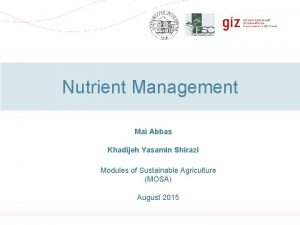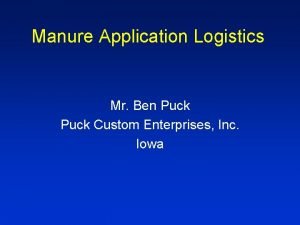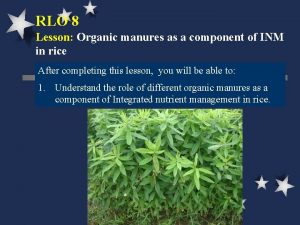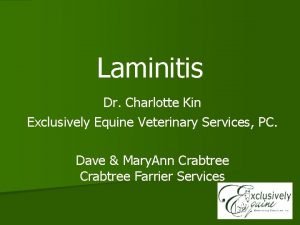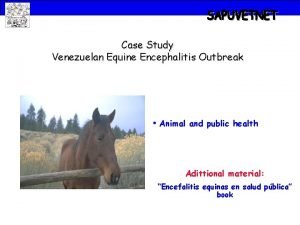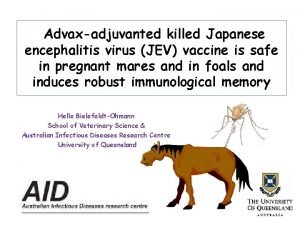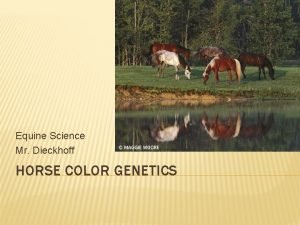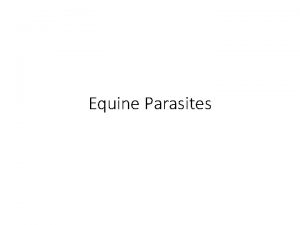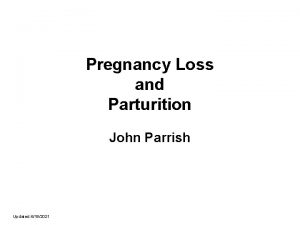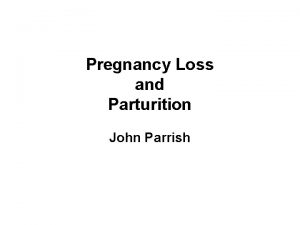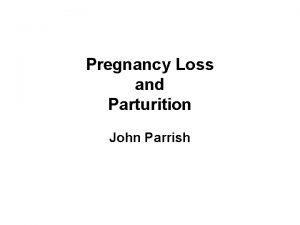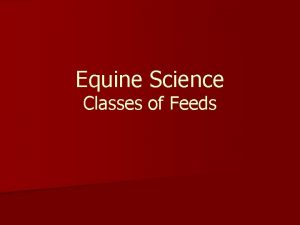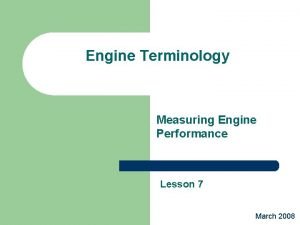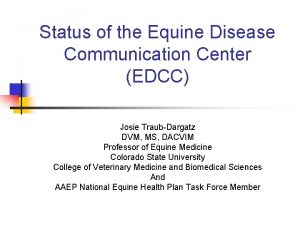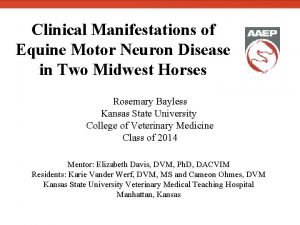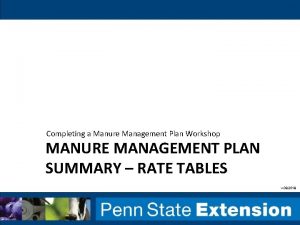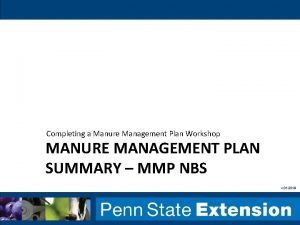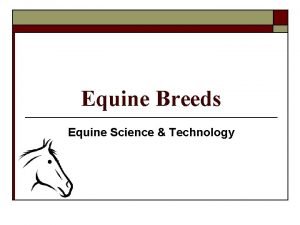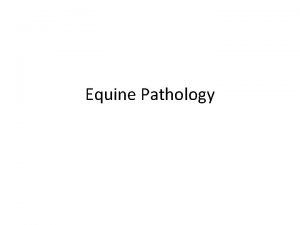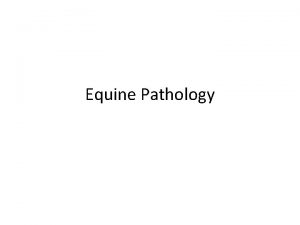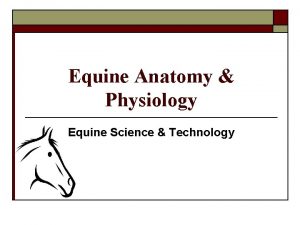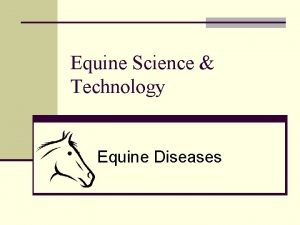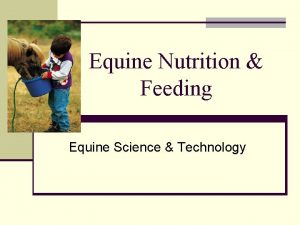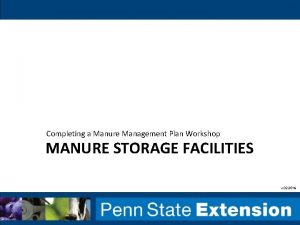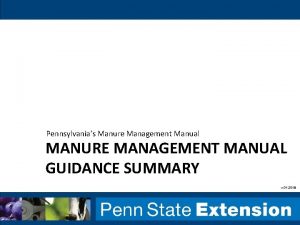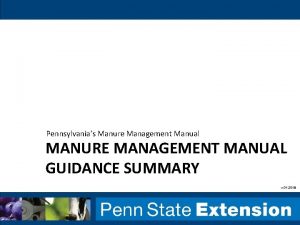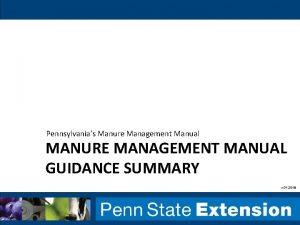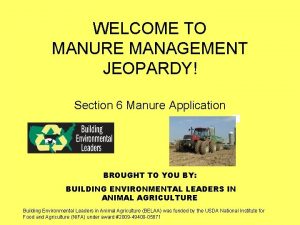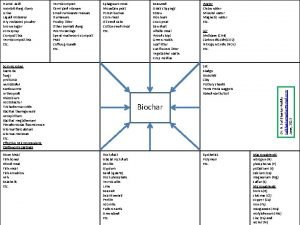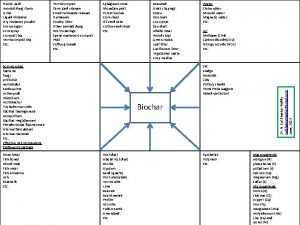Manure Management Plan Writing For the Equine Owner
























- Slides: 24

Manure Management Plan Writing For the Equine Owner

v. Why Regulations? v. What’s at Stake? v. Who’s Effected?

WHY? What’s the Concern? ØSediments ØNutrients

Water Quality • KEEP CLEAN WATER CLEAN!! • Sediment • Nutrients – Nitrogen – Phosphorus • Biggest threat to surface water quality

What is Erosion & Sedimentation? • RAIN A bomb raid for bare soil! • DETACHMENT Rain drops on bare soil break apart soil aggregates

TRANSPORTATION Detached soil particles are suspended and move with flowing water

DEPOSITION – Suspended soil particles are deposited – where?

Sediment in Streams • Biggest water pollutant in PA by volume • Increases turbidity (murky, muddy water) • • • Degrades water quality Increases water temperature/decreases oxygen levels Clogs fish gills Suffocates bottom dwelling organisms Prevents sunlight from reaching aquatic plants Disrupts aquatic ecosystems

SEDIMENT NEVER TRAVELS ALONE…

Manure … What is it? • Manure is a valuable resource • Organic matter and soil microbes • Micro (zinc, calcium, magnesium) nutrients • Macro (N- P -K) nutrients • Substitute for commercial fertilizers – Provides plants essential nutrients – Slow release of nutrients • Increases infiltration of water, and water holding capacity

The Scoop on Poop … In one year: • PA produces 26, 000 tons of manure (excluding equine) • A horse produces 20, 000 lbs of manure • A dairy cow produces 2, 500 gallons of milk and 6, 000 gallons of manure • A pig gains 250 lbs in 5 months and produces 2, 000 lbs of manure Less than 25% of PA equine farms use their manure.

Nutrients • In the process of producing, storing, transporting and land applying manure, pathogens and nutrients (Nitrogen & Phosphorus) can leach or be transported to surface and ground waters • All affect water quality

Nutrients: Nitrogen • Can be carried into surface waters with eroded sediments • Can leach into ground water • Presents a human health and livestock risk when present in drinking water • Very dynamic and mobile

Climate, temperature, handling and incorporation all affect nitrogen loss.

Nutrients: Phosphorus • Excess nutrients (especially phosphorous) cause aquatic plants and algae to bloom • As aquatic vegetation dies, oxygen is depleted and aquatic animals die • Enters surface waters primarily through EROSION

Chesapeake Bay Watershed


WHO is Regulated? Ø All Animal Operations (AOs) Ø All operations generating/utilizing manure Ø Regulated by PA DEP (PA Clean Streams Law) Ø Concentrated Animal Operations (CAOs) Ø Animal Density greater than 2 AEUs/Acre Ø 1 AU = 1000 lbs Ø 8 or more AEUs Ø Regulated by PA State Conservation Commission (Act 38) AOs (40, 000+) CAOs (1, 050+) CAFOs (365+) Ø Concentrated Animal Feeding Operations (CAFOs) Ø Based on animal numbers and/or animal density Ø Farms >1, 000 AEUs, CAOs >300 AEUs Ø Regulated by PA DEP (for US EPA)

DEP Manure Management Plan Act 38 Nutrient Management Plan Written By Farmer Certified nutrient management planner Cost May be of no cost to farmer $ varies by operation Who Needs One Farms with livestock and/or that apply manure Concentrated Animal Operations; Volunteer Farms Regulates Animal Concentration Areas Manure Storage Pasture Mechanical Manure Application Agency Regulated by DEP/ Conservation Districts Regulated by SCC/ Conservation Districts Approval None required Approved by Conservation District Board Liability Protection None claimed Limited liability for civil complaints

Example Problem A horse operation with 10 horses on 10 acres is regulated differently then 10 horses on 4 acres. 10 horses on 10 acres AEU = 10 AEU/Acre = 1 Manure Management Plan 10 horses on 4 acres AEU = 10 AEU/Acre = 2. 5 Nutrient Management Plan

Animal No. Days on X Weight ÷ 1000 = AU X ÷ 365 = AEUs Type Animals Farm (lbs) Mature Draft Horse 3 X ÷ 1000 = 5. 4 X X ÷ 1000 = X ÷ 365 = 1800 Total AU = 1, 000 lbs 365 ÷ 365 = Total AEU = Acres available for ÷ manure Animal Density: AEU/ = Acre Concentrated Animal Operation (CAO) : More than 2 AEU/Acre AND More than 8 AEUs 5. 4

Total Manure Production Animal Daily Manure Days on Total Manure AU X X ÷ 2, 000 = Type Production * Farm Produced Mature Draft Horse 5. 4 X 55 lb/ AU/ Day X 365 ÷ 2, 000 = X X ÷ 2, 000 = Total Manure Produced = 54 Tons

Total Uncollected Manure Animal Daily Manure Days on AU X X X Type Production* Pasture Mature Draft Horse 5. 4 X 55 lb/AU/Day X 280 X Hours Uncollected on ÷ 24 ÷ 2, 000 = Manure Pasture 11 ÷ 24 ÷ 2000 = X X X ÷ 24 ÷ 2000 = Total Uncollected Manure = 19 Tons

Total Collected Manure TOTAL Manure Produced 54 Tons - UNCOLLECTED Manure = Collected Manure - 19 Tons = * 35 Tons - = Amount of manure needed to be stored and/or spread
 Definition of green manure
Definition of green manure Definition of green manure
Definition of green manure Puck custom enterprises
Puck custom enterprises Manure
Manure Bulky organic manure examples
Bulky organic manure examples Chapter 18 renewable energy
Chapter 18 renewable energy Charlotte kin test
Charlotte kin test Lingfield equine vets
Lingfield equine vets Equine definition
Equine definition Uspc stall card
Uspc stall card Equine encephalitis
Equine encephalitis Equine encephalitis
Equine encephalitis Pasture pals equine rescue
Pasture pals equine rescue Rhinopneumonitis definition
Rhinopneumonitis definition Horse color calculator
Horse color calculator Equine
Equine Equine
Equine Equine
Equine Equine
Equine Equine science
Equine science Equine science
Equine science Indicated horsepower formula
Indicated horsepower formula Equine disease communication center
Equine disease communication center Rto incompass
Rto incompass Equine motor neuron disease
Equine motor neuron disease

